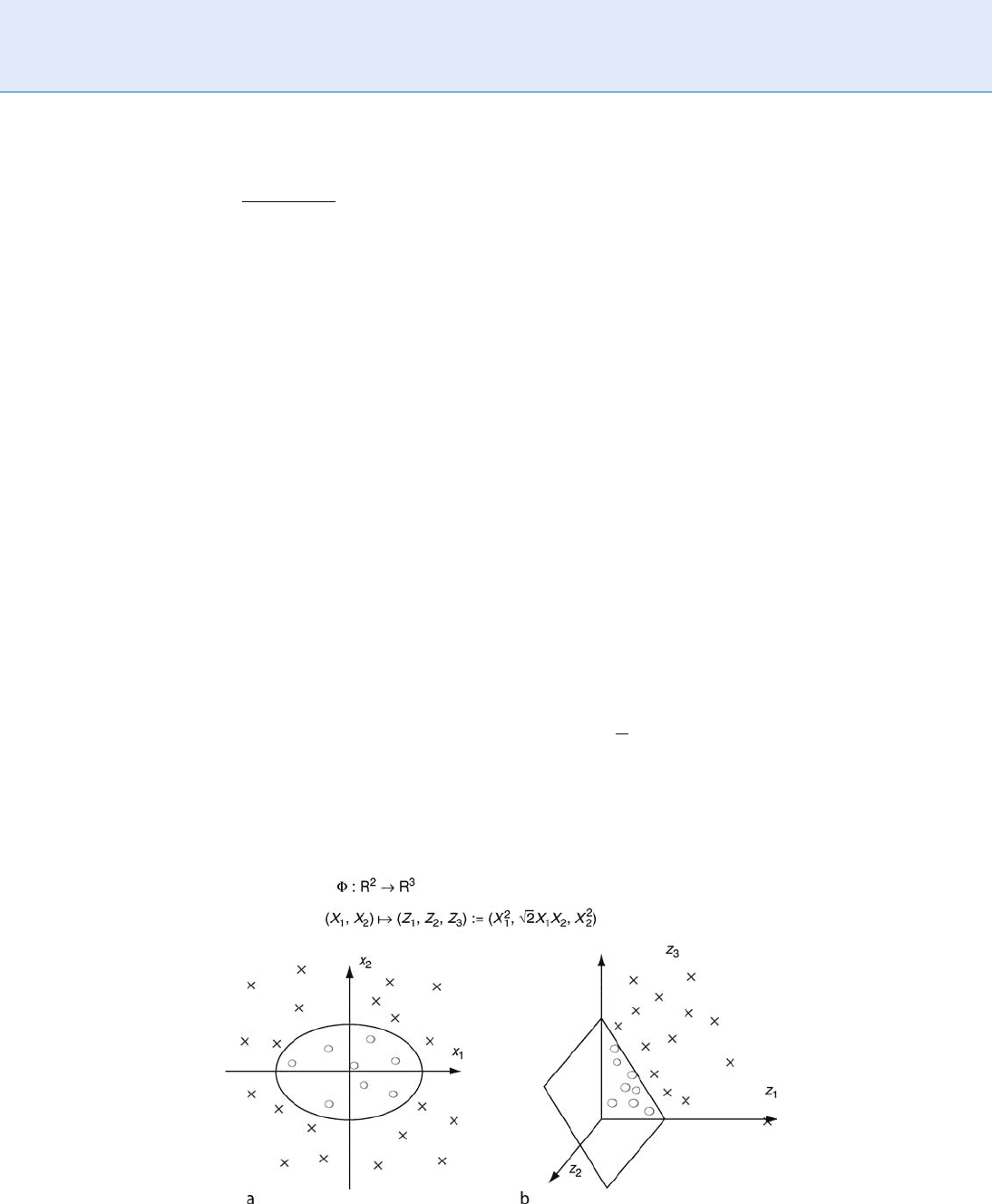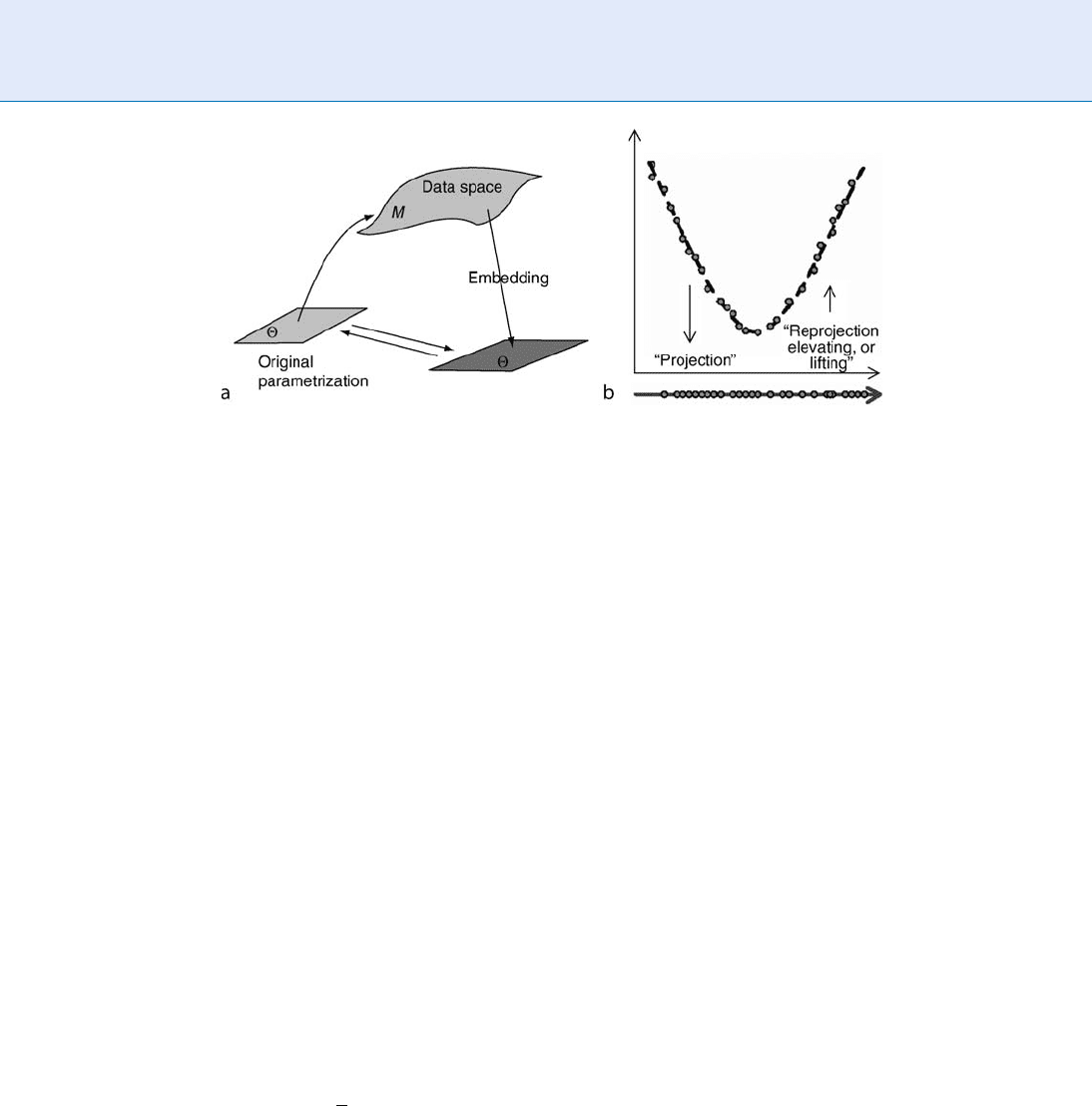Li S.Z., Jain A.K. (eds.) Encyclopedia of Biometrics
Подождите немного. Документ загружается.



N
NAP-SVM
The main goal of the SVM Nuisance Attribute Projec-
tion (NAP) method is to reduce the impact of channel
variations (called also session variability). It uses an
appropriate projection matrix P in the SVM super-
vector space (a supervector is obtained by concatenat-
ing the Gaussian means) to remove the subspace that
contains the session variability.
s
0
¼ P s; ð1Þ
where, s is a GMM supervector. The projection matrix
can be written as follow:
P ¼ðI VV
t
Þ; ð2Þ
where, V ¼½v
1
; :::; v
k
is a rectangular matrix of
low rank whose columns are orthonormal. The vec-
tors v
k
are obtained from the k eigenvectors having
the k largest eigenvalues of the following covariance
matrix:
1
S
X
S
s ¼1
1
n
s
X
n
s
i¼1
ð
m
s
i
m
s
i
Þð
m
s
i
m
s
i
Þ
t
ð3Þ
where
m
s
i
represents the GMM supervector of the ith
session of the sth speaker. S is the number of speaker in
V -Matrix training data. n
s
is the number of different
sessions belonging to the sth speaker.
m
s
i
is the mean
GMM supervector obtained overall the sessions be-
longing to the sth speaker:
m
s
i
¼
1
n
s
X
n
s
i¼1
m
s
i
: ð4Þ
▶ Session Effects on Speaker Modeling
National Institute for Standards and
Technology
▶ Fingerprint, Forensic Evidence of
Natural Gradient
When a parameter space has a certain underlying
structure, the ordinary gradient (partial derivative) of
a function does not represent its steepest direction.
Riemannian space is a curved manifold where, there is
no orthonormal linear coordinates. The steepest descent
direction in a Riemannian space is given by the ordinary
gradient pre-multiplied by the inverse of Riemannian
metric. Such direction is referred to as natural gradient.
▶ Independent Component Analysis
Near Field Communication
Synonym
NFC
Definition
A method of wireless communication that uses mag-
netic field induction to send data over very short dis-
tances (less than 20 cm). NFC is intended primarily
for deployment in mobile handsets.
▶ Transportable Asset Protection
#
2009 Springer Science+Business Media, LLC

Near Infrared (NIR)
Electromagnetic radiation, identical to visible light, ex-
cept at wavelengths longer than red light; the near infra-
red band (IR-A) extends from 700 to 1,400 nm, while
the whole infrared region ranges from 700 to 3,000 nm.
▶ Face Recognition, Near-infrared
▶ Finger Vein
▶ Iris Databases
▶ Iris Device
▶ Palm Vein
Near-infrared Image Based Face
Recognition
▶ Face Recognition, Near-Infrared
NEXUS
▶ Iris Recognition at Airports and Border-Crossings
NIST SREs (Speaker Recognition
Evaluations)
Evaluations of speaker recognition systems coordina-
ted by the National Institute of Standards and Tech-
nology (NIST) in Gaithersburg, MD, USA, 1996–2008.
▶ Speaker Databases and Evaluation
Noisy Iris Challenge Evaluation –
Part I (NICE.I)
The Noisy Iris Challenge Evaluation – Part I (NICE.I)
began in 2007 by the University of Beira Interior.
The NICE.I contest focuse s on the development of
new iris segmentation and noise detection techniques
unlike similar contest which focus more on iris
recognition performance. The iris database used for
the contest, UBIRIS.v2, consists of very noisy iris
images to simulate less constraining image capturing
conditions.
▶ Iris Databases
Nominal Identity
Nominal identity represents the name and in certain
cases the other abstract concepts associated with
a given indiv idual (e.g . the Senator, the Principal,
the actor). Such an identity is malleable and distin-
guished from the less mutable biometric identity,
which is typically predicated on physiological or
behavioral characteristics that do not change much
over time.
▶ Fraud Reduction, Applications
Non-ideal Iris
Non-ideal iris is defined as dealing with off-angle,
occluded, blurred, noisy images of iris.
▶ Iris Image Quality
Non-linear Dimension Reduction
Methods
▶ Non-linear Techniques for Dimension Reduction
1002
N
Near Infrared (NIR)

Non-linear Techniques for
Dimension Reduction
JIAN YANG,ZHONG JIN,JINGYU YANG
School of Computer Science and Technology, Nanjing
University of Science and Technology, Nanjing, Peoples
Republic of China
Synonyms
Non-linear dimension reduction methods
Definition
Dimension reduction refers to the problem of con-
structing a meaningful low-dimensional representation
of high-dimensional data. A dimension reduction tech-
nique is generally associated with a map from a high-
dimensional input space to a low-dimensional output
space. If the associated map is non-linear, the dimen-
sion reduction technique is known as a non-linear
dimension reduction technique.
Introduction
Dimension reduction is the construction of a
meaningful low-dimensional representation of high-
dimensional data. Since there are large volumes
of high-dimensional data (such as climate patterns,
stellar spectra, or gene distributions) in numerous
real-world applications, dimension reduction is a fun-
damental problem in many scientific fields. From the
perspective of pattern recognition, dimension reduc-
tion is an effective means of avoiding the ‘‘curse
of dimensionality’’ and improving the computational
efficiency of pattern matching.
Researchers have developed many useful dimension
reduction techniques. These techniques can be broadly
categorized into two classes: linear and no n-linear.
Linear dimension reduction seeks to find a meaningful
low-dimensional subspace in a high-dimensional
input space. This subspace can provide a compact
representation of high-dimensional data when the
structure of data embedded in the input space is linear.
The principal component analysis (PCA) and Fisher
linear discriminant analysis (LDA or FLD) are two
well-known linear subspace learning methods which
have been extensively used in pattern recognition and
computer vision areas and are the most popular tech-
niques for face recognition and other biometrics.
Linear models, however, may fail to discover essen-
tial data structures that are non-linear. A number of
non-linear dimension reduction techniques have been
developed to address this problem, with two in partic-
ular attracting wide attention:
▶ kernel-based techni-
ques and
▶ manifold learning related techniques. The
basic idea of kernel-based techniques is to implicitly
map observed patterns into potentially much higher
dimensional feature vectors by using non-linear
mapping determined by a kernel. This makes it possi-
ble for the non-linear structure of data in observation
space to become linear in feature space, allowing the
use of linear techniques to deal with the data. The
representative techniques are kernel principal compo-
nent analysis (KPCA) [1] and kerne l Fisher discrimi-
nant analysis (KFD) [2, 3]. Both have proven to be
effective in many real-world applications.
In contrast with kernel-based techniques, the mo-
tivation of manifold learning is straightforward, as it
seeks to directly find the intrinsic low-dimensional
non-linear data structures hidden in observation
space. Over the past few years many manifold learning
algorithms for discovering intrinsic low-dimensional
embedding of data have been proposed. Among
the most well-known are isometric feature mapping
(ISOMAP) [4], local linear embedding (LLE) [5],
and Laplacian Eigenmap [6]. Some experiments
demonstrated that these methods can find perceptually
meaningful embeddings for face or digit images. They
also yielded impressive results on other artificial and
real-world data sets. Recently, Yan et al. [7] proposed a
general dimension reduction framework called graph
embedding. LLE, ISOMAP, and Laplacian Eigenmap
can all be reformulated as a unified model in this
framework.
Kernel-Based Non-Linear Dimension
Reduction Techniques
Over the last 10 years, kernel-based dimension reduc-
tion techniques, represented by kernel principal compo-
nent analysis (KPCA), and kernel Fisher discriminant
analysis (KFD), have been extensively applied to
biometrics and have been proved to be effective. The
basic idea of KPCA and KFD is as follows.
Non-linear Techniques for Dimension Reduction
N
1003
N

By virtue of a non-linear mapping F, the input data
space R
n
is mapped into the feature space H
_
:
F: R
n
! H
:
x 7! F xðÞ
ð1Þ
As a result, a pattern in the original input space R
n
is
mapped into a potentially much higher dimensional
feature vector in the feature space H
_
. KPCA is to per-
form PCA in the feature space, while KFD is to perform
LDA in such a space.
This description reveals the essence of the KPCA
and KFD methods, but it does not suggest an effective
way to implement these two methods, because the
direct operation in the high-dimensional or possibly
infinite-dimensional feature space is computationally
so intensive or even becomes impossible. Fortunately,
kernel tricks can be introduced to address this prob-
lem. The algorithms of KPCA and KFD can be imple-
mented in the input space by virtue of kernel tricks. An
explicit non-linear map and any operation in the fea-
ture space are not required at all.
To explain what a kernel trick is and how it works,
B. Scho
¨
lkopf [8] gave an example, as shown in Fig. 1.
In the example, the two-class data is linearly non-
separable in the two-dimensional input space. That is,
one cannot find a projection axis by using any linear
dimension reduction technique such that the projected
data is separable on this axis. To deal with this problem,
the data can be transformed into a feature space by
the map F given in Fig. 1. As a result, the data become
linear separable in the yielding three-dimensional
feature space, thereby the linear dimension reduction
technique can be applied in such a space. To imple-
ment a linear dimension reduction technique in the
feature space, one needs to calculate the inner product
as follows:
hFðxÞ; Fðx
0
Þi ¼ ðx
2
1
;
ffiffiffi
2
p
x
1
x
2
; x
2
2
Þðx
02
1
;
ffiffiffi
2
p
x
0
1
x
0
2
; x
02
1
Þ
T
¼hx; x
0
i
2
¼ :kðx; x
0
Þ
Therefore, the inner product operation can be expres-
sed by a 2-order polynomial kernel function. In this
way, the operation of the inner product in the feature
space is essentially avoided, as it can be calculated in
the input space via a kernel function. In addition, one
need not construct an explicit map, since the map is
completely determined by the kernel function.
Now, KPCA and KFD can be outlined as follows.
Given a set of M training samples x
1
; x
2
; ; x
M
in
R
n
, the covariance operator on the feature space H
_
can
be constructed by
S
F
t
¼
X
M
j¼1
Fðx
j
Þm
F
0
Fðx
j
Þm
F
0
T
ð2Þ
where m
F
0
¼
1
M
P
M
j¼1
Fðx
j
Þ, and F is a map into the
feature space H
_
which is determined by a kernel k.In
a finite-dimensional Hilbert space, this operator is
generally called the covariance matrix.
Non-linear Techniques for Dimension Reduction. Figure 1 An example of kernel mapping. (a) The data is linearly non-
separable in the input space. (b) The data is linearly separable in the mapped feature space.
1004
N
Non-linear Techniques for Dimension Reduction

It is easy to show that every eigenvector of S
F
t
, b,
can be linearly expanded by
b ¼
X
M
i¼1
a
i
Fðx
i
Þ: ð3Þ
To obtain the expansion coefficients, one can con-
struct the M M Gram matr ix K with elements
K
ij
¼ kðx
i
; x
j
Þ and centralize K as follows
~
K ¼ðI DÞKðI DÞ; where I is the
identity matrix and D ¼ð1
=
MÞ
MM
:
ð4Þ
Calculate the orthonormal eigenvectors v
1
; v
2
; ; v
m
of
~
K corresponding to the m largest positive eigenva-
lues l
1
; l
2
; ; l
m
. The orthonormal eigenvectors
b
1
; b
2
; ; b
m
of S
F
t
corresponding to the m largest
positive eigenvalues l
1
; l
2
; ; l
m
are
b
j
¼
1
ffiffiffiffi
l
j
p
Qv
j
j ¼ 1; ; m
where
Q ¼ Fðx
1
Þ; ; Fðx
M
Þ½
ð5Þ
After the projection of the centered, mapped sample
FðxÞ on to the eigenvector system b
1
; b
2
; ; b
m
,
one can obtain the KPCA-transformed feature vector
y by
y ¼ðb
1
; b
2
; ; b
m
Þ
T
½FðxÞm
F
0
¼ L
1
2
V
T
Q
T
½FðxÞm
F
0
¼ L
1
2
V
T
ðI DÞðK
x
KD
1
Þ
ð6Þ
where
L ¼ diagðl
1
; l
2
; ; l
m
Þ; V ¼½v
1
; v
2
; ; v
m
;
and
K
x
¼ kðx
1
; xÞ; kðx
2
; xÞ; ; kðx
M
; xÞ½
T
and
D
1
¼ð1=MÞ
M1
:
KFD seeks a set of optimal discriminant vectors by
maximizing the Fisher criterion in the feature space.
KFD can be derived in the similar way as used in KPCA.
That is, the Fisher discriminant vector can be expanded
using Eq. (3) and then the problem is formulated in a
space spanned by all mapped training samples. (For
more details, please refer to [2, 3].) Recent works
[9, 10] revealed that KFD is equivalent to KPCA plus
LDA. Based on this result, a more transparent KFD
algorithm has been proposed. That is, KPCA is first
performed and then LDA is used for a second dimen-
sion reduction in the KPCA-transformed space.
Manifold Learning Related Non-Linear
Dimension Reduction Techniques
Of late, manifold learning has become very popular in
machine learning and pattern recognition areas. As-
sume that the data lie on a low-dimensional manifold.
The goal of manifold learning is to find a low-dimen-
sional representation of data, and to recover the struc-
ture of data in an intrinsically low-dimensional space.
To gain more insight into the concept of manifold
learning, one can begin with a fundamental problem:
how is the observation data on a manifold generated?
Suppose the data is generated by the following model:
f ðYÞ!X; ð7Þ
where Y is the parameter set, and f can be viewed as a
non-linear map. Then, its inverse problem is: how can
one recover the parameter set without knowing the
map f ? How can one build a map f from the data
space to the parameter space? Manifold learning
seeks answers to these problems. The process of
manifold learning is illustrated in Fig . 2 ; Fig . 2 (a)
presents a general process of manifold learning [11],
and Fig . 2( b) shows an example of how to find a
one-dimensional embedding (parameter set) from
the two-dimensional data lying on a one-dimensional
manifold [12].
Many manifold learning related dimension reduc-
tion techniques have been developed over the last few
years. Among the most well-known are isometric fea-
ture mapping (ISOMAP) [4], local linear embedding
(LLE) [5], and Laplacian Eigenmap [6]. Here, LLE can
be considered as an example to introduce manifold
learning related dimension reduction techniques.
Let X ¼fx
1
; x
2
; ; x
N
g be a set of N points in a
high-dimensional observation space
R
n
. The data points are assumed to lie on or close
to a low-dimensional manifold. LLE seeks to find a
low-dimensional embedding of X by mapping the data
into a single global coordinate system in R
d
(d < n).
The corresponding set of N points in the embedding
space R
d
can be denoted as Y ¼fy
1
; y
2
; ; y
N
g.
The LLE algorithm is outlined in the following
three steps.
Non-linear Techniques for Dimension Reduction
N
1005
N

Step 1: For each data point x
i
2 X, find K nearest
neighbors of x
i
. Let O
i
¼fjjx
j
belongs to the set
of K nearest neighbors of x
i
g
Step 2: Reconstruct x
i
from its K nearest neighbors
identified. The reconstruction weights can be
obtained by minimizing the reconstruction error
e
i
¼ x
i
X
j
w
ij
x
j
2
; ð8Þ
subject to
P
j
w
ij
¼ 1 and w
ij
¼ 0 for any j =2 O
i
.
Suppose the optimal reconstruction weights are
w
ij
ði; j ¼ 1; 2; ; NÞ.
Step 3: Compute d-dimensional coordinates y
i
by
minimizing the embedding cost function
FðyÞ¼
X
i
y
i
X
j
w
ij
y
j
2
: ð9Þ
subject to the following two constraints
X
i
y
i
¼ 0 and
1
N
X
i
y
i
y
T
i
¼ I; ð10Þ
where I is an identity matrix.
The process of LEE algorithm is illustrated in Fig. 1 of
SVM and Kernal Method by Scho
¨
lkopf [8].
Although some previous experiments have demon-
strated that the LEE and ISOMAP methods can pro-
vide perceptually meaningful representation for facial
expression or pose variations, these manifold learning
methods may not be suitable for biometric recogni-
tion tasks. [13] First, the goal of these manifold
learning algorithms has no direct connections to clas-
sification. Second, these algorithms are inconvenient
to deal with new samples because the involved non-
linear map is unknown. How to model biometric
manifolds and develop effective manifold learning
algorithms for classification purp oses deserve further
investigation.
Summary
Two kinds of non-linear dimension reduction techni-
ques, kernel-based methods and manifold learning
related algorithms, have been introduced here. The
mechanism of kernel methods is to increase the dimen-
sion first by an implicit non-linear map determined by
a kernel and then to reduce the dimension in the
feature space, while that of manifold learning related
algorithms is to reduce the dimension directly via a
non-linear map. Recent research on these two kinds of
dimension reduction techniques has revealed an inter-
esting result: manifold learning al gorithms, such as
ISOMAP, local linear LLE, and Laplacian Eigenmap,
can be described from a kernel po int of view [14].
Related Entries
▶ Biometrics, Overview
▶ Kernel Methods
▶ Linear Techniques for Dimension Reduction
▶ Manifold Learning
▶ Non-Linear Dimension Reduction Methods
Non-linear Techniques for Dimension Reduction. Figure 2 Illustration of the process of manifold learning. (a) A general
process of manifold learning [11]. (b) An example of how to derive a one-dimensional embedding from the
two-dimensional data lying on a one-dimensional manifold [12].
1006
N
Non-linear Techniques for Dimension Reduction

References
1. Scho
¨
lkopf, B., Smola, A., Muller, K.R.: Nonlinear component
analysis as a kernel eigenvalue problem. Neural Comput. 10(5),
1299–1319 (1998)
2. Mika, S., Ra
¨
tsch, G., Weston, J., Scho
¨
lkopf, B., Mu
¨
ller, K.R.:
Fisher discriminant analysis with kernels. IEEE International
Workshop on Neural Networks for Signal Processing IX, Madi-
son (USA), August 1999, pp. 41–48
3. Baudat, G., Anouar, F.: Generalized discriminant analysis using a
kernel approach. Neural Comput. 12(10), 2385–2404 (2000)
4. Tenenbaum, J.B., de Silva, V., Langford, J.C.: A global geometric
framework for nonlinear dimensionality reduction. Science 290,
2319–2323 (2000)
5. Roweis, S.T., Saul, L.K.: Nonlinear dimensionality reduction
by locally linear embedding. Science. 290, 2323–2326 (2000)
6. Belkin, M., Niyogi, P.: Laplacian eigenmaps for dimensionality
reduction and data representation. Neural Comput. 15(6),
1373–1396 (2003)
7. Yan, S., Xu, D., Zhang, B., Zhang, H.J., Yang, Q., Lin, S.: Graph
embedding and extensions: A general framework for dimension-
ality reduction. IEEE Trans. Pattern Anal. Mach. Intell. 29(1),
40–51 (2007)
8. Scho
¨
lkopf, B.: SVM and Kernel Method. http://www.kernel-
machines.org/
9. Yang, J., Jin, Z., Yang, J.Y., Zhang, D., Frangi, A.F.: Essence
of Kernel Fisher Discriminant: KPCA plus LDA, Pattern Recogn.
37(10), 2097–2100 (2004)
10. Yang, J., Frangi, A.F., Yang, J.Y., Zhang, D., Zhong, J.: KPCA plus
LDA: A complete kernel fisher discriminant framework for fea-
ture extraction and recognition. IEEE Trans. Pattern. Anal.
Mach. Intell. 27(2), 230–244 (2005)
11. Grimes, C., Donoho, D.: Can these things really work? Theoretical
Results for ISOMAP and LLE, a presentation at the Workshop of
Spectral Methods in Dimensionality Reduction, Clustering, and
Classification in NIPS 2002. http://www.cse.msu.edu/lawhiu/
manifold/
12. McMillan, L.: Dimensionality reduction Part 2: Nonlinear meth-
ods. http://www.cs.unc.edu/Courses/comp290-90-f03/
13. Yang, J., Zhang, D., Yang, J.Y., Niu, B.: Globally maximizing,
locally minimizing: Unsupervised discriminant projection with
applications to face and palm biometrics. IEEE Trans Pattern
Anal. Mach. Intell. 29(4), 650–664 (2007)
14. Ham, J., Lee, D., Mika, S., Scho
¨
lkopf, B.: A kernel view of the
dimensionality reduction of manifolds. In: Proceedings of the
Twenty-First International Conference on Machine Learning,
Alberta, Canada, pp. 369–376 (2004)
Normalised Hamming Distance
▶ Score Normalization Rules in Iris Recognition
Nuisance Attribute Projection
▶ Session Effects on Speaker Modeling
Numerical Standard
Minimal number of corresponding minutiae between a
fingermark and a fingerprint necessary for a formal
identification, in absence of significant difference.
▶ Fingerprint, Forensic Evidence of
Numerical Standard
N
1007
N


O
Object Recognition
Given a few training image of the same target object
(same object, bu t may be viewed from different ang les
or position), the goal of object recognition is to retrieve
the same object in other unseen images. It is a difficult
problem because the target object in unseen image may
appear different from what it appears in the training
image, due to the variation of view points, background
clutter, ambient illumi nation, partially occluded by
other object or deformation of the object itself. A
good object recognition algorithm is supposed to be
able to recognize target object given all of the above
variations.
▶ Iris Super-Resolution
Observations from Speech
▶ Speaker Features
Ocular Biometrics
▶ Retina Recognition
Odor Biometrics
ADEE A. SCHOON
1
,ALLISON M. CURRAN
2
,
K
ENNETH G. FURTON
2
1
Animal Behavior Group, Leiden University, Leiden,
The Netherlands
2
Department of Chemistry and Biochemistry,
International Forensic Research Institute, Florida
International University, Miami, FL, USA
Synonyms
Osmology; Scent identification line-ups
Definition
Human odor can be differentiated among individuals
and can therefore be see n as a biometric that can be
used to identify this person. Dogs have been trained to
identify objects held by a specific person for forensic
purposes from the beginning of the twentieth centur y.
Advancing technology has made it possible to identify
humans based on
▶ headspace analysis of objects they
have handled, opening the route to the use of odor as a
biometric.
Introduction
From the early twentieth century, dogs have been used
to find and identify humans based on their odor. This
has originated from the capacity of dogs to follow the
track of a person, either by following the odor the
person left directly on the ground that the dog needed
to follow quite closely (‘‘tracking’’), or by following
a broader odor trail that the dogs could follow at
some distance (‘‘trailing’’). Some dogs were very
#
2009 Springer Science+Business Media, LLC
